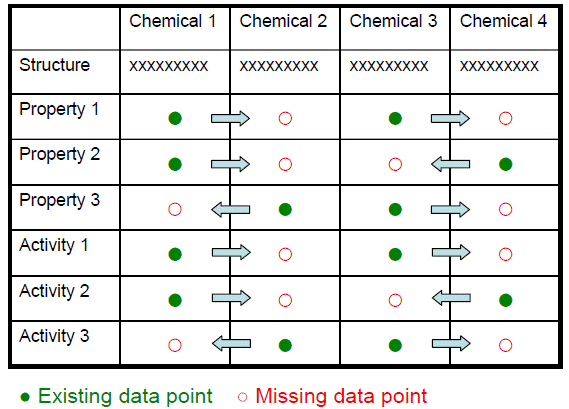For a general chemical substance registration, except some special types such as polymer registration, intermediate registration, etc., the testing fee ranges from tens of thousands to hundreds of throusands. For purpose of animal welfare, saving time and cost, the following methods may replace animal test:
- QSAR,
- READ-ACROSS,
- In-vitro method, and
- Weight of Evidence (WOE).
QSAR
Quantitative structure–activity relationship models (QSAR models) are mathematic models used to describe the relationship between chemical structures and biological activities. When chemical structure and biological activities are expressed by algorithm, one can find a mathematical relationship, such as linear regression, neural network, support vector machine (SVM), genetic algorithm (GA), decision-making tree etc. In other words, QSAR models can predict the activities or properties of some substances.
In practical uses, selecting an appropriate, predictable and verified model to predict the biological activity of an unknown chemical is crucial. It is reasonable if the results obtained from different models or methods coincide with each other. If you have sufficient example data (training set), you can use some existing QSAR software to establish your own models, verify models and predict the biological activities of unknown chemicals with the models.
QSAR software which is frequently used includes OECD Toolbox, TOPKAT, Discovery Studio, SYBLE, ACD/Labs, Multicase, EPI SUITE, ECOSAR and so on.
Grouping/Category and Read-Across
The properties of familiar chemicals tend to be same. Following a result of structural similarity, substances can be considered as a group, or ‘category’. In order to fill the data gap of physical-chemical, toxicological and eco-toxicological properties in a group, READ-ACROSS method can be used to refer to existing endpoints of chemicals in the group. This method can save data cost by avoiding unnecessary testing for each chemical.

In vitro Method
In vitro testing involved eye irritation, skin irritation and skin sensitization are most-frequently used;
- Skin irritation/corrosion: OECD439, OECD430, OECD431 and OECD435
- Eye irritation: OECD 437, OECD438 and OECD460
- Skin allergic test: OECD442C, OECD442D and H-CLAT
The acceptance of in vitro methods are not the same under different legal systems (for example, it is different between EU REACH registration and China new chemical substance registration), hence, case by case.
Weight of Evidence (WOE)
There may be sufficient weight of evidence from several independent sources of information leading to the assumption/conclusion that a substance has or has not a particular dangerous property, while the information from each single source alone is regarded insufficient to support this notion.
Our services
- Establish QSAR model, to estimate physicochemical, toxicological and eco-toxicological properties of the target chemical as well as to prepare professional QMRF and QPRF reports;
- Estimate the physicochemical, toxicological or eco-toxicological property of the target chemical through internationally recognized commercial software such as TOPKAT, ACD/Labs, Discovery Studio and so on, as well as to prepare professional QMRF and QPRF reports;
- Fill data gaps by READ-ACROSS or Grouping method;
- In-vitro testing consulting;
- To prepare evaluation report based on WOE. To make predictions in the physicochemical, toxicological and eco-toxicological properties for purpose of chemical, cosmetics as well as pesticide registrations.
If you need any assistance or have any questions, please get in touch with us via service@cirs-group.com.
Further Information
EU Vigorously Advances Animal Testing Alternatives, OECD 416 and UDS Removed

